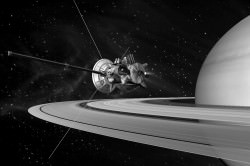Planet come in a wide variety of sizes, compositions, and colors – and they can sometimes have rings. Where do these rings come from?
My favorite object to see through a telescope is Saturn. Seriously, if you’ve never had a chance to see it with your own eyes, find a friend who owns a telescope and ask them to see Saturn. Do it right now, I’ll wait.

Don’t have a friend with a telescope? First, I think you should examine your choice in friends. You should always have a friend with a truck, and you should always have a friend with a telescope. Then search Google for your closest astronomy club, find out when they have their monthly meeting, join them, and ask to see Saturn. These will be your new friends.
Why is Saturn so amazing to see? The rings of course. Saturn’s rings are huge, just the ones you can see with your eyes extend about 140,000 kilometers above the surface of the planet. There are other, fainter rings that extend outward for million of kilometers more.
Although the rings look huge and dense, they’re actually gossamer thin; as little as 10 meters at their thinnest points. Like, the thickness of a two-story house.
And Saturn isn’t the only planet in the Solar System with rings. Astronomers have discovered rings around Jupiter, Uranus and Neptune, and each of these is different from the others.

Why do planets get rings? Does Earth have rings, or did it have any in the past? What would they look like? Astronomers have looked at all the planets in the Solar System with rings and then worked backwards to figure out how and when those rings were formed.
Although we’re most familiar with Saturn, the source of the planet’s rings have actually been largely a mystery until the last few years. Astronomers didn’t know if the rings are as ancient as the planet itself, or relatively brand new.
They look brand new, like young ice, but appearances are deceiving. New evidence from NASA’s Cassini spacecraft indicates that the particles in the rings are constantly clumping and breaking up again, making the ice look new.
But Cassini detected gradual accumulation of dust into the ring system at a rate that allows the rings to be billions of years old.

This means that Saturn’s rings probably formed right at the beginning of the Solar System, an icy moon that could never get its act together.
Jupiter’s rings, on the other hand, have a different origin story. Observations from NASA’s New Horizons spacecraft determined that the rings are made up of particles blasted into space from micrometeorite impacts with Jupiter’s moons. The rings are being constantly replenished.
The rings around Uranus and Neptune are still a mystery. They’re made of very dark material, like soot, with some organic molecules. It’s possible they’re formed and replenished through some kind of interaction between the planets’ magnetospheres and their surrounding environment.

ESO/L. Calçada/M. Kornmesser/Nick Risinger (skysurvey.org)
Not only can planets have rings, but moons might have rings too. Astronomers were studying the environment around Saturn’s second largest moon Rhea. They noticed three concentrations of plasma on both sides of the moon, as if there were symmetric rings around the moon. They haven’t seen the rings directly, but 1-meter wide rings would explain these observations.
Asteroids can have rings too. The asteroid Chariklo was observed by astronomers as it passed in front of a background star. They were looking for moons, but instead, they detected a ring. It’s likely the ring was formed out of debris caused by collisions with the asteroid.
Earth doesn’t have rings today, but it’s possible we got into the rings game in the past. When a massive asteroid impacted the planet, it would have thrown up a cloud of rock and vaporized dinosaurs into orbit. This temporary ring would then slowly crash back down to Earth, piece by piece, skull by skull.

Kevin Gill, a software engineer at NASA’s Jet Propulsion Laboratory put Saturn-like rings into his own vacation photos. You can see what it would look like if Earth had rings like Saturn. Very impressive.
Tell me about the first time you ever saw Saturn with your own eyes in a telescope. And if you’ve never seen the planet and its rings, I’d like to hear your promise that you’re going to cross that off your bucket list this year.


The story does not answer the question in the headline. The story is just ooooh, aaaah, rings. No causation, no reason they form rings instead of a cloud of debris.
I also remember one of the speculations on how to deal with global warming was to put up an artificial ring system to shade the earth….